
Feel free to add tags, names, dates or anything you are looking for
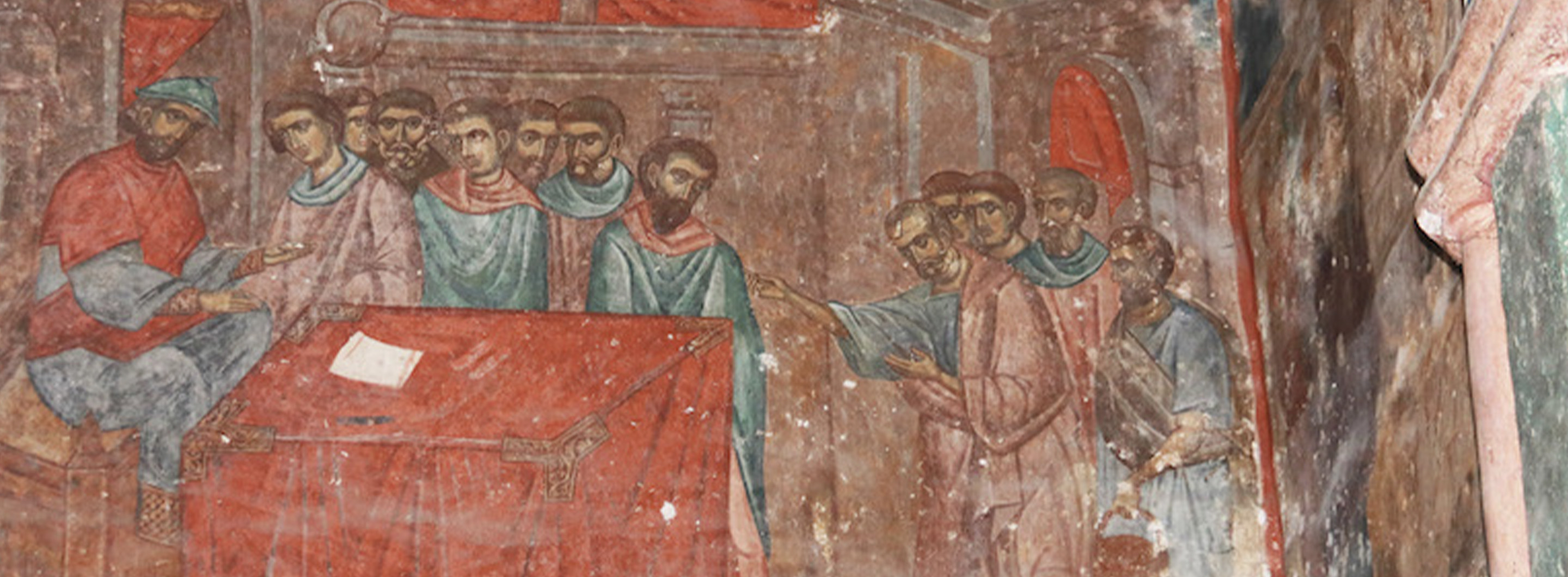

Zarzma Church of the Dormition of the Virgin is located in Samtskhe, a historical southern region of Georgia. The first church was built here in the 9th century. It was founded by the holy monk St. Serapion of Zarzma. The church was reconstructed several times, the most recent being at the turn of the 13th-14th centuries. The church is a cross-in-square building with a tripartite arched gallery to the south. It is built of well-cut ashlars. It is characterized by features common to Georgian architecture from the second half of the 13th and the 14th centuries. Nearby the church is a belfry that dates from the same period.

Zarzma, church of the Dormition of the Virgin, turn of the 13th -14th cc
The entire interior of the church is adorned with wall paintings that underwent several stages of repainting and restoration. The primary layer is dated to the late 13th – early 14th centuries, and reflects the typical Palaeologan style. On the south wall are preserved the portraits of several members of the powerful Jakeli feudal family, who ruled this region between the 13th and15th centuries. However, during the 16th century a major portion of the murals were repainted and some new compositions were added (e.g. a new row of ktetors on the northern wall). Notwithstanding the remarkable differences in style, the main structure of the compositions and the iconography of the scenes from the 14th century were more or less preserved. In certain places, fragments of the 14th century painting can be discerned.
At the beginning of the 20th century, by order of the Russian authorities, “restoration “of the murals was carried out by the Russian painter, A. Slavtsev. The original style and artistic form of the 13th-14th century images, as well as those from the 16th century, underwent serious alterations. More than half of the entire wall decoration was repainted and modified (the paintings in the dome, the apse, and the chancel bay, among others). Nevertheless, certain parts, particularly those in the upper zones of the walls, seem to have been left intact.
Zarzma, church of the Dormition of the Virgin, Interior. South cross-arm
Despite all of these changes, the original program of the murals can easily be identified and reflects the 13th-14th century approach, which is extremely interesting both from an iconographic and from an iconological point of view.
The arrangement of the wall paintings is rather complex, and the scenes are grouped in an elaborate series of programs. It is apparent that the Zarzma wall murals do not contain a single program, but rather a series of programs that interact to both divide and unify the various spaces within the church. The images sought to convey a range of messages, and can be interpreted on a number of different levels.
The layout of the scenes and their order within the cross-arms are not based on either a chronological or liturgical sequence. Rather, the scenes are grouped according to cycles: the cycle of the Virgin in the southern cross-arm, the Christological cycle in the northern cross-arm, and the Passion cycle in the western arm. In some cases, scenes from one cycle are included in other space, for instance the Baptism is added to the Passion cycle, among other examples. The main themes of the overall program are the Sacrifice, the Incarnation, the Salvation and the Immaculate Conception.
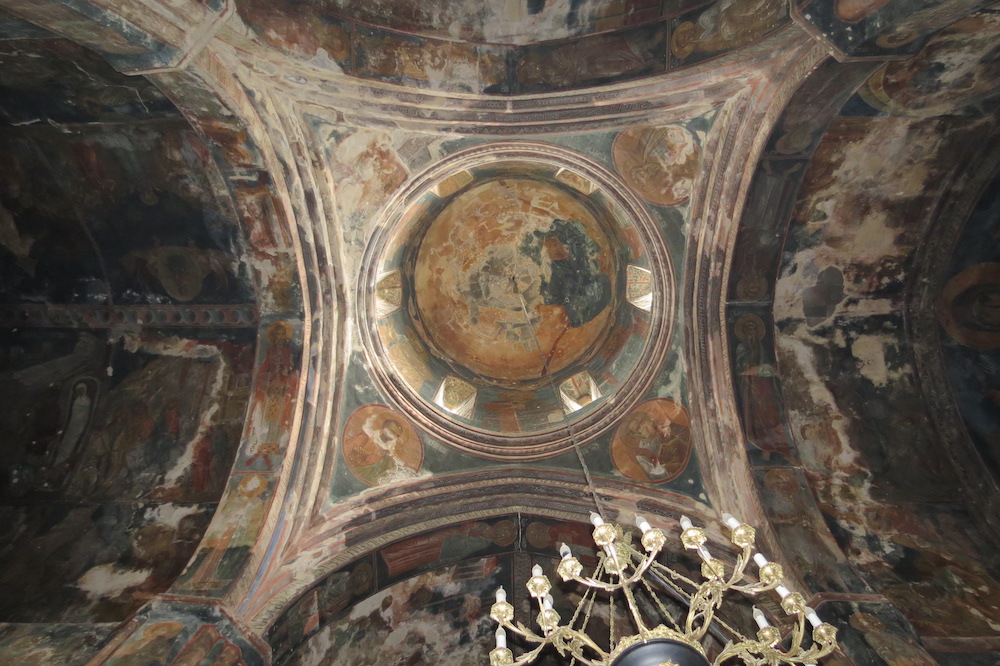
Zarzma, church of the Dormition of the Virgin, the dome
The dome features the Ascension of Christ accompanied by six figures of angels. Between the windows of the tambour of the dome, figures of Biblical Prophets and the Virgin are portrayed. The circular corniche around the base of the dome features a Georgian inscription with texts from the Bible (Genesis, 1: 1-3), while on the supporting arches there are inscriptions with citations from the Psalms.
In the pendentives, the Evangelists are represented en buste inscribed in medallions – an iconographic feature characteristic of Georgian murals throughout the 13th and 14th centuries.
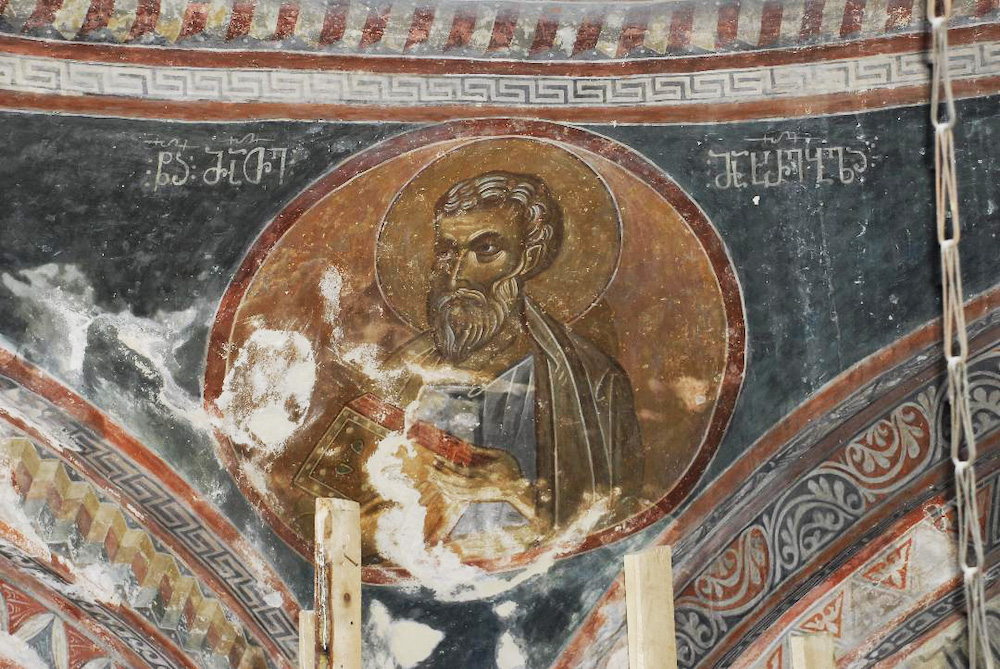
Zarzma, church of the Dormition of the Virgin, pendentive, Evangelist Mathiew
In the conch of the apse there is an image of the Virgin and Child (Cypriotissa), with two figures of venerating angels on either side. Underneath there is a composition of the Communion of the Apostles, and in the lower register, in the niches, there are figures of the Holy Bishops.
Zarzma, church of the Dormition of the Virgin, the Sanctuary
Several rare scenes are illustrated on the walls of the chancel bay: Wisdom Has Built Her House, and the Burning Bush in the upper registers; the Liturgical Service in the Tabernacle and Jacob’s Ladder beneath, as well as figures of the Prophets Ezekiel, Daniel, Gideon, and others. In the middle of the lower part of the apse, there is a rare image of the Anapeson (a reclining figure of Christ-Emanuel, sleeping with open eyes and with two angels venerating Him (Psalm 120)) – subject matter that was introduced into Palaeologan art from the late 13th century.

Zarzma, church of the Dormition of the Virgin, the sanctuary, Anapeson
Above the entrance to the prosthesis, a large figure of the Archangel Michael and a small kneeling figure of Joshua the son of Nun are represented, while over the diaconicon entrance a figure of the Archangel Gabriel is portrayed.

Zarzma, church of the Dormition of the Virgin, Presentation of the Virgin in the Temple
The program of the southern cross-arm is dedicated to the cycle of the Life of the Virgin based on the apocryphal Protoevangelium of James, and comprises several rare iconographical themes: the Rejection of the Sacrifice, the Nativity of the Virgin, the Virgin blessed by the Priests, the Virgin caressed by her Parents, the Presentation of the Virgin at the Temple, the Dream of Joseph, the High Priest Zachariah praying at the Altar, the Virgin receiving the Skein of Purple Wool, the Virgin returning the Purple Veil, the Betrothal, the Virgin entrusted to Joseph, the Reproaches of Joseph, the Ordeal by Water, and the Visitation.
Zarzma, church of the Dormition of the Virgin, the Virgin caressed by her parents; Reproaches of Joseph
In the lower register of this cross-arm there are portraits of members of the feudal family of Jakeli (Sargis I, Beka, Sargis II, Kuarkvare), rulers of the newly independent province of Samtskhe-Saatabago. It is noteworthy that the Georgian inscription identifies Sargis II as a Commander in Chief, as well as the Chief of the Painters (!). Their portraits serve as a historical basis for dating the original painting, although as mentioned above, significant repainting was carried out in the 16th century, as well as at the beginning of the 20th century. In addition, the portraits themselves appear to have been retouched by the 16th century painters.
Zarzma, church of the Dormition of the Virgin, members of Jakeli Family, rulers of Samtskhe-Saatabago
The northern cross-arm contains the Christological Cycle: the Annunciation, the Nativity, the Journey to Bethlehem, the Presentation at the Temple, the Circumcision, the Transfiguration, the Agony in the Garden, Jesus Christ before the High Priests Annas and Caiaphas, the Crucifixion, the Anastasis, the Descent from the Cross, Joseph of Arimathea asking Pilate for the Body of Christ, the Incredulity of St. Thomas, and the Hetoimasia.
Zarzma, church of the Dormition of the Virgin Joseph of Arimathea asking from Pilate the body of Christ
On the northern wall there is a portrait of Euthymius, Catholicos of Kartli standing before Christ, as well as members of the Khurtsidze family – one of whom, Father Serapion the Archbishop of Atskuri, is receiving a sygelion and epigonation from Bagrat III, King of Kings from Imereti (western Georgia). On the northern pillar, there is a portrait of Symeon Gurieli, Prince of Svaneti and Minister of the Court.
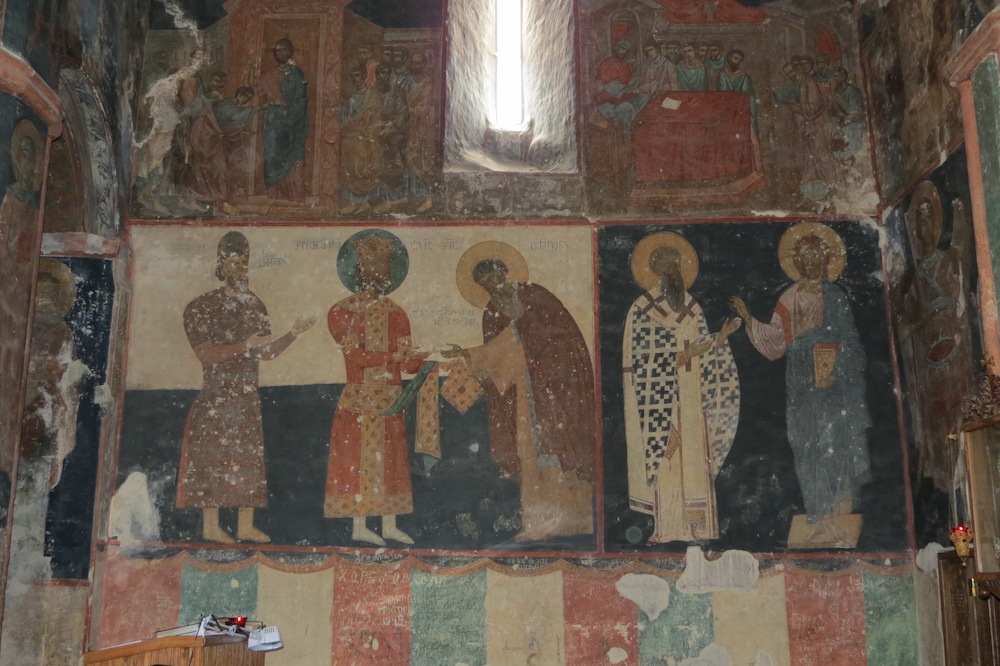
Archbishop of Atskuri, Father Serapion receives sygelion and an epigonation from Bagrat III, King of Kings of Imereti; Euthymius, Catholicos of Kartli standing before Christ
All of these individuals were active during the 16th century, thus determining the date of the second stage of church decoration, while also explaining the stylistic features of a portion of the murals that is different from the Palaeologan style of the original layer, and closer in manner to Post-Byzantine art. There is also a portrait of the 9th century feudal lord Giorgi Chorchaneli, a supporter of St. Serapion of Zarzma.

Bagrat III, King of Kings of Imereti
The murals in the western cross-arm are dedicated to the Passions of Christ: the Resurrection of Lazarus, the Entry into Jerusalem, the Agony in the Garden, the Washing of Feet, the Last Supper, the Betrayal of Judas, Christ before Annas and Caiaphas, the Mocking of Christ (Crowning with Thorns), the Baptism, the Holy Women at the Tomb, the Preparation of the Cross, the Flagellation, the Lamentation (Threnos), the Entombment, the Pentecost, the Dormition of the Virgin, the Mission to the Apostles, Abraham meets the Angels, and the Hospitality of Abraham. In the lower register, numerous figures of individual saints are portrayed.

Pentecost and Hospitality of Abraham.
In the north-western bay of the interior, Daniel in the Lions’ Den and the Three Babylon Youths in the Fiery Furnace are depicted; while in the south-western bay, the Virgin’s Supper and the Virgin praying to her Son are illustrated – which are also newer themes in the mural programs.
Along with the “standard” subject matters that are widespread in Orthodox art over the centuries, many rare scenes can be seen at Zarzma that were introduced into the Palaeologan period proper, especially those from the Old Testament and prophetic visions – such as Wisdom Has Built Her House, the Service in the Tabernacle, and the Anapeson, as well as apocryphal themes from the Life of the Virgin ( Joseph reproaches the Virgin, the Ordeal by Water, The Virgin’s Supper, and many others).

Zarzma, church of the Dormition of the Virgin, murals on the north wall
As previously mentioned, the order of the scenes follows neither a chronological nor a liturgical sequence. It must be noted that the program of Zarzma Church is extremely sophisticated and comprised of many scenes and images, some of which are quite rare in Georgian art. They demonstrate an elaborate theology that is conveyed in a visual form.
Numerous inscriptions are preserved in the old Georgian majuscule script Asomtavruli, including citations from the Bible, the titles of the scenes, and the names of the ktetors.
The style of these murals reveals strict adherence to the artistic language of Palaeologan art: an increased number of registers, as well as compositions; a multiplication of the figures; the extremely detailed and intensely dynamic structure of the compositions; a distinctly pronounced narrative character; emphasized emotions; developed background settings (landscape and architecture); and many themes from the Bible bearing symbolic and didactic content, among others.
Fortunately, it appears that the 16th century artists repeated and followed the Palaeologan models. Nonetheless, the 16th century paintings bear the distinct traits of Post-byzantine art. The difference in stylistic approach between the Palaeologan and Post-byzantine periods is obvious. The drawing and outlines are coarser, heavier and more angular; the modeling is simpler and somewhat primitive, with the movement of the figures being more static; the emotions are expressed more indifferently and frigidly; the coloring of the murals seems now to be rather dark and gloomy in comparison with the clearer and brighter colors on the fragments of Palaeologan painting that have remained intact.
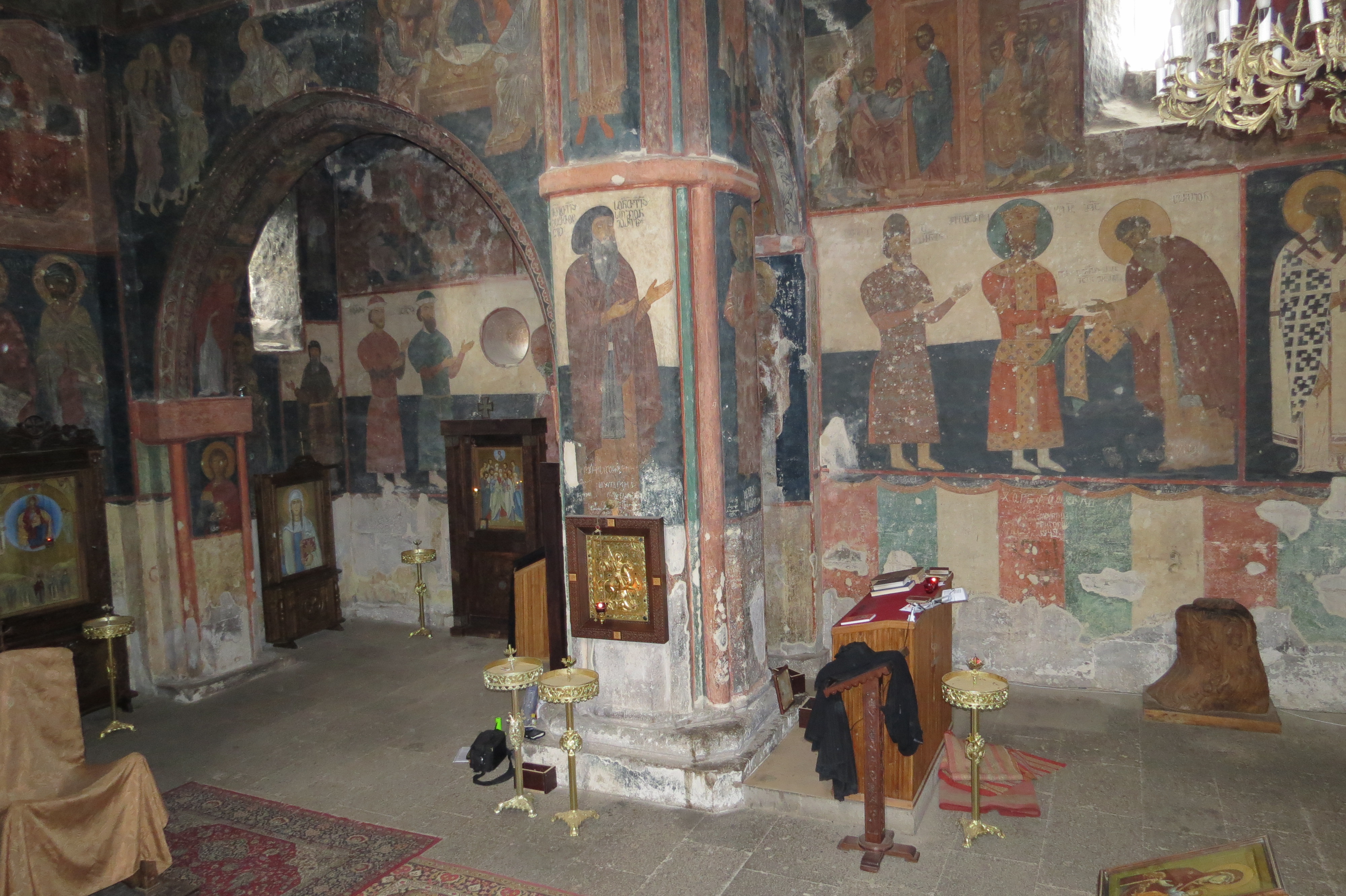
Zarzma, church of the Dormition of the Virgin, interior of the church, view to the north
In spite of all these significant alterations, the Zarzma murals are still considered to be an outstanding example of Georgian wall painting from the turn of the 13th and 14th centuries – a period when the new Palaeologan style was introduced into Georgian art, and which witnessed the interaction between Georgian and Byzantine art. At the same time, the Zarzma murals reveal many specific traits that were inspired by the age-old traditions of medieval Georgian wall painting.